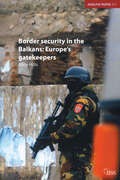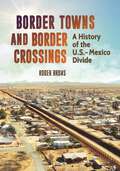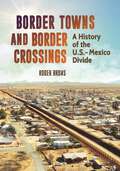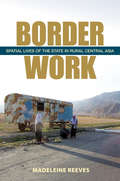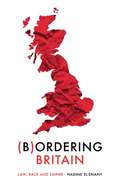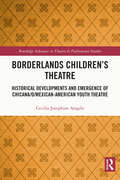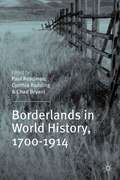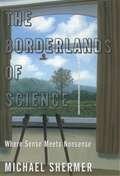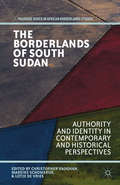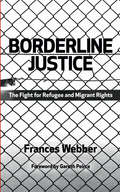- Table View
- List View
Border Security in the Balkans: Europe Gatekeepers (Adelphi series)
by Alice HillsBorders dominate the security agenda in South-east Europe. Political and ethnic discontents focus on disputed borders, while traffickers in migrants and drugs ignore them.The EU argues that the Balkan countries should develop models of border management using its policing standards, but the region is rife with corruption and its border guards are both under-resourced and ineffective. This Paper asks how and why border management in South-east Europe is developing as it is, and what this might mean for the future of Europe. Drawing on recent experience in Bosnia, Herzegovina, Slovenia, Macedonia and Albania, it looks at the ways in which the regions' borders are managed, and gauges the development of a consensual European approach to border security. It shows how governments and guards understand the predicament of regional insecurity, and how they respond with strategies that accommodate, evade or subvert unavoidable political pressures.
Border Security in the Balkans: Europe Gatekeepers (Adelphi series)
by Alice HillsBorders dominate the security agenda in South-east Europe. Political and ethnic discontents focus on disputed borders, while traffickers in migrants and drugs ignore them.The EU argues that the Balkan countries should develop models of border management using its policing standards, but the region is rife with corruption and its border guards are both under-resourced and ineffective. This Paper asks how and why border management in South-east Europe is developing as it is, and what this might mean for the future of Europe. Drawing on recent experience in Bosnia, Herzegovina, Slovenia, Macedonia and Albania, it looks at the ways in which the regions' borders are managed, and gauges the development of a consensual European approach to border security. It shows how governments and guards understand the predicament of regional insecurity, and how they respond with strategies that accommodate, evade or subvert unavoidable political pressures.
Border Towns and Border Crossings: A History of the U.S.-Mexico Divide
by Roger BrunsThis is a compelling and revealing look at the history of the U.S.-Mexico border as a place, a symbol of cross-cultural melding, and a source of growing anxiety over immigration and national security.The U.S.-Mexico border is far more than a line that separates two countries. A winding path of nearly 2,000 miles from the Pacific Ocean to the Gulf of Mexico, it is history, commerce, and culture. In recent years, however, attitudes about border crossings and border issues have hardened as has immigration policy. A source of growing anxiety over illegal immigration, national security, and safety, the border has become a symbol of political cataclysm over immigration law and enforcement, the future of DACA, the increasingly harsh treatment of refugees and others who attempt to cross without authorization, and the future of U.S. policy. This book traces the history of the border and its people, from the creation of the border line to explosive issues surrounding immigration and the future of the United States as a nation of diverse cultures and races.
Border Towns and Border Crossings: A History of the U.S.-Mexico Divide
by Roger BrunsThis is a compelling and revealing look at the history of the U.S.-Mexico border as a place, a symbol of cross-cultural melding, and a source of growing anxiety over immigration and national security.The U.S.-Mexico border is far more than a line that separates two countries. A winding path of nearly 2,000 miles from the Pacific Ocean to the Gulf of Mexico, it is history, commerce, and culture. In recent years, however, attitudes about border crossings and border issues have hardened as has immigration policy. A source of growing anxiety over illegal immigration, national security, and safety, the border has become a symbol of political cataclysm over immigration law and enforcement, the future of DACA, the increasingly harsh treatment of refugees and others who attempt to cross without authorization, and the future of U.S. policy. This book traces the history of the border and its people, from the creation of the border line to explosive issues surrounding immigration and the future of the United States as a nation of diverse cultures and races.
The Border Trilogy: Picador Classic (Picador Classic #65)
by Cormac McCarthyWith an introduction by novelist Rachel KushnerIn the vanishing world of the Old West, two cowboys begin an epic adventure, and their own coming-of-age stories. In All the Pretty Horses, John Grady Cole’s search for a future takes him across the Mexican border to a job as a ranch hand and an ill-fated romance. The Crossing is the story of sixteen-year-old Billy Parham, who sets off on a perilous journey across the mountains of Mexico, accompanied only by a lone wolf. Eventually the two come together in Cities of the Plain, in a stunning tale of loyalty and love.A true classic of American literature, The Border Trilogy is Cormac McCarthy’s award-winning requiem for the American frontier. Beautiful and brutal, filled equally with sorrow and humour, it is a powerful story of two friends growing up in a world where blood and violence are conditions of life.
Border Wars: The conflicts of tomorrow
by Professor Klaus DoddsHow are borders built in the modern world? What does Brexit mean for Ireland's border? And what would happen if Elon Musk declared himself president of the Moon?In Border Wars, Professor Klaus Dodds takes us on a journey into the geopolitical conflict of tomorrow in an eye-opening tour of the world's best-known, most dangerous and most unexpected border conflicts from the Gaza Strip to the space race. Along the way, we'll discover just what border truly mean in the modern world: how are they built; what do they mean for citizens and governments; how do they help understand our political past and, most importantly, our diplomatic future?
Border Wedding (Border Trilogy #2)
by Amanda ScottCaptured in 1388 in the act of stealing back his own cattle, young Sir William Scott faces hanging, then gets one other choice--to marry immediately his captor's eldest daughter, the lady Margaret Murray, known by all as Muckle-Mouth Meggie. With the line between England and Scotland shifting daily, the Earl of Douglas wants to win back every inch of Scotland that the English have claimed; whereas the equally powerful English Percies (under Hotspur) want to win back the land between Northumberland and Edinburgh; and the Murray family is caught in the middle, shifting its alliances to try to survive. Uncertain whether she is English or Scottish and abruptly married to Sir William who is staunchly loyal to the cause of Scottish independence but who also has promised he'll never take up arms against her family, Meg Murray learns two things: first, Will's word is his bond; second, her favorite brother is spying on Douglas for Hotspur. As Sir Will faces the dilemma of honoring his word to the unscrupulous Murray without betraying Douglas, Meg must choose between betraying the husband with whom she is rapidly falling in love, or betraying her own family and best-loved brother.
The Border Within: The Economics of Immigration in an Age of Fear
by Tara Watson Kalee ThompsonAn eye-opening analysis of the costs and effects of immigration and immigration policy, both on American life and on new Americans. For decades, immigration has been one of the most divisive, contentious topics in American politics. And for decades, urgent calls for its policy reform have gone mostly unanswered. As the discord surrounding the modern immigration debate has intensified, border enforcement has tightened. Crossing harsher, less porous borders makes unauthorized entry to the United States a permanent, costly undertaking. And the challenges don’t end on the other side. At once enlightening and devastating, The Border Within examines the costs and ends of America’s interior enforcement—the policies and agencies, including ICE, aimed at removing immigrants already living in the country. Economist Tara Watson and journalist Kalee Thompson pair rigorous analysis with deeply personal stories from immigrants and their families to assess immigration’s effects on every aspect of American life, from the labor force to social welfare programs to tax revenue. What emerges is a critical, utterly complete examination of what non-native Americans bring to the country, including immigration’s tendency to elevate the wages and skills of those who are native-born. News coverage has prompted many to question the humanity of American immigration policies; The Border Within opens a conversation of whether it is effective. The United States spends billions each year on detention and deportation, all without economic gain and at a great human cost. With depth and discipline, the authors dissect the shock-and-awe policies that make up a broken, often cruel system, while illuminating the lives caught in the chaos. It is an essential work with far-reaching implications for immigrants and non-immigrants alike.
The Border Within: The Economics of Immigration in an Age of Fear
by Tara Watson Kalee ThompsonAn eye-opening analysis of the costs and effects of immigration and immigration policy, both on American life and on new Americans. For decades, immigration has been one of the most divisive, contentious topics in American politics. And for decades, urgent calls for its policy reform have gone mostly unanswered. As the discord surrounding the modern immigration debate has intensified, border enforcement has tightened. Crossing harsher, less porous borders makes unauthorized entry to the United States a permanent, costly undertaking. And the challenges don’t end on the other side. At once enlightening and devastating, The Border Within examines the costs and ends of America’s interior enforcement—the policies and agencies, including ICE, aimed at removing immigrants already living in the country. Economist Tara Watson and journalist Kalee Thompson pair rigorous analysis with deeply personal stories from immigrants and their families to assess immigration’s effects on every aspect of American life, from the labor force to social welfare programs to tax revenue. What emerges is a critical, utterly complete examination of what non-native Americans bring to the country, including immigration’s tendency to elevate the wages and skills of those who are native-born. News coverage has prompted many to question the humanity of American immigration policies; The Border Within opens a conversation of whether it is effective. The United States spends billions each year on detention and deportation, all without economic gain and at a great human cost. With depth and discipline, the authors dissect the shock-and-awe policies that make up a broken, often cruel system, while illuminating the lives caught in the chaos. It is an essential work with far-reaching implications for immigrants and non-immigrants alike.
Border Work: Spatial Lives of the State in Rural Central Asia (Culture and Society after Socialism)
by Madeleine ReevesDrawing on extensive and carefully designed ethnographic fieldwork in the Ferghana Valley region, where the state borders of Kyrgyzstan, Tajikizstan and Uzbekistan intersect, Madeleine Reeves develops new ways of conceiving the state as a complex of relationships, and of state borders as socially constructed and in a constant state of flux. She explores the processes and relationships through which state borders are made, remade, interpreted and contested by a range of actors including politicians, state officials, border guards, farmers and people whose lives involve the crossing of the borders. In territory where international borders are not always clearly demarcated or consistently enforced, Reeves traces the ways in which states' attempts to establish their rule create new sources of conflict or insecurity for people pursuing their livelihoods in the area on the basis of older and less formal understandings of norms of access. As a result the book makes a major new and original contribution to scholarly work on Central Asia and more generally on the anthropology of border regions and the state as a social process. Moreover, the work as a whole is presented in a lively and accessible style. The individual lives whose tribulations and small triumphs Reeves so vividly documents, and the relationships she establishes with her subjects, are as revealing as they are engaging. Border Work is a well-deserved winner of this year’s Alexander Nove Prize.
Bordering Britain: Law, race and empire (Manchester University Press)
by Nadine El-Enany(B)ordering Britain argues that Britain is the spoils of empire, its immigration law is colonial violence and irregular immigration is anti-colonial resistance. In announcing itself as postcolonial through immigration and nationality laws passed in the 60s, 70s and 80s, Britain cut itself off symbolically and physically from its colonies and the Commonwealth, taking with it what it had plundered. This imperial vanishing act cast Britain’s colonial history into the shadows. The British Empire, about which Britons know little, can be remembered fondly as a moment of past glory, as a gift once given to the world. Meanwhile immigration laws are justified on the basis that they keep the undeserving hordes out. In fact, immigration laws are acts of colonial seizure and violence. They obstruct the vast majority of racialised people from accessing colonial wealth amassed in the course of colonial conquest. Regardless of what the law, media and political discourse dictate, people with personal, ancestral or geographical links to colonialism, or those existing under the weight of its legacy of race and racism, have every right to come to Britain and take back what is theirs.
Bordering Britain: Law, race and empire (Manchester University Press)
by Nadine El-Enany(B)ordering Britain argues that Britain is the spoils of empire, its immigration law is colonial violence and irregular immigration is anti-colonial resistance. In announcing itself as postcolonial through immigration and nationality laws passed in the 60s, 70s and 80s, Britain cut itself off symbolically and physically from its colonies and the Commonwealth, taking with it what it had plundered. This imperial vanishing act cast Britain’s colonial history into the shadows. The British Empire, about which Britons know little, can be remembered fondly as a moment of past glory, as a gift once given to the world. Meanwhile immigration laws are justified on the basis that they keep the undeserving hordes out. In fact, immigration laws are acts of colonial seizure and violence. They obstruct the vast majority of racialised people from accessing colonial wealth amassed in the course of colonial conquest. Regardless of what the law, media and political discourse dictate, people with personal, ancestral or geographical links to colonialism, or those existing under the weight of its legacy of race and racism, have every right to come to Britain and take back what is theirs.
Borderland: A Journey Through the History of Ukraine
by Anna ReidBorderland tells the story of Ukraine. A thousand years ago it was the center of the first great Slav civilization, Kievan Rus. In 1240, the Mongols invaded from the east, and for the next seven centureies, Ukraine was split between warring neighbors: Lithuanians, Poles, Russians, Austrians, and Tatars. Again and again, borderland turned into battlefield: during the Cossack risings of the seventeenth century, Russia's wars with Sweden in the eighteenth, the Civil War of 1918-1920, and under Nazi occupation. Ukraine finally won independence in 1991, with the collapse of the Soviet Union. Bigger than France and a populous as Britain, it has the potential to become one of the most powerful states in Europe.In this finely written and penetrating book, Anna Reid combines research and her own experiences to chart Ukraine's tragic past. Talking to peasants and politicians, rabbis and racketeers, dissidents and paramilitaries, survivors of Stalin's famine and of Nazi labor camps, she reveals the layers of myth and propaganda that wrap this divided land. From the Polish churches of Lviv to the coal mines of the Russian-speaking Donbass, from the Galician shtetlech to the Tatar shantytowns of Crimea, the book explores Ukraine's struggle to build itself a national identity, and identity that faces up to a bloody past, and embraces all the peoples within its borders.
Borderland: A Journey Through the History of Ukraine
by Anna ReidA classic and vivid history of Ukraine, fully updated to cover the Euromaidan Revolution of 2014 and ongoing crisis in the Donbass.Centre of the first great Slav civilisation in the tenth century, then divided between warring neighbours for a millennium, Ukraine finally won independence with the collapse of the Soviet Union. Tiring of their own corrupt governments, Ukrainians have since mounted two popular revolutions, taking to the streets to demand fair elections and closer ties to Europe. In the spring of 2014, Russia responded by invading Crimea and sponsoring a civil war in the Russian-speaking Donbass. Threatened by Moscow, misunderstood in the West, Ukraine hangs once more in the balance. Speaking to pro-democracy activists and pro-Russia militiamen, peasants and miners, survivors of Hitler's Holocaust and Stalin's famine, Anna Reid combines history and travel-writing to unpick the past and present of this bloody and complex borderland.'Beautifully written and lovingly researched' Daily Telegraph'Gripping history' The Times
Borderland: A Journey Through the History of Ukraine
by Anna ReidFULLY UPDATED'A fascinating and often violent odyssey, spanning more than 1,000 years of conflict and culture'INDEPENDENTFlat, fertile, and fatally tempting to invaders, for centuries Ukraine was fought over by more powerful neighbours. Though its modern national movement dates back to the early nineteenth century, it did not win real independence until 1991, with the collapse of the Soviet Union.Since then, Ukrainians have proved themselves one of the world's most remarkable nations. In 2014 mass demonstrations forced out a corrupt pro-Russian president. Russia responded by invading, first seizing Crimea and the eastern Donbass, and then in February 2022 marching on Kyiv. With Western help, Ukraine is fighting back. But in what form it will emerge from the war - the bloodiest in Europe since 1945 - remains to be seen.For this fourth edition of her classic history, Anna Reid returns to the scene. Talking to refugees, politicians and victims of widespread Russian war crimes, she adds a new chapter to the complex biography of a country on the frontline of the conflict between democracy and dictatorship.
Borderland Capitalism: Turkestan Produce, Qing Silver, and the Birth of an Eastern Market
by Kwangmin KimScholars have long been puzzled by why Muslim landowners in Central Asia, called begs, stayed loyal to the Qing empire when its political legitimacy and military power were routinely challenged. Borderland Capitalism argues that converging interests held them together: the local Qing administration needed the Turkic begs to develop resources and raise military revenue while the begs needed access to the Chinese market. Drawing upon multilingual sources and archival material, Kwangmin Kim shows how the begs aligned themselves with the Qing to strengthen their own plantation-like economic system. As controllers of food supplies, commercial goods, and human resources, the begs had the political power to dictate the fortunes of governments in the region. Their political choice to cooperate with the Qing promoted an expansion of the Qing's emerging international trade at the same time that Europe was developing global capitalism and imperialism. Borderland Capitalism shows the Qing empire as a quintessentially early modern empire and points the way toward a new understanding of the rise of a global economy.
The Borderlands: An Encyclopedia of Culture and Politics on the U.S.-Mexico Divide
by Andrew Grant WoodThe more than 2,000-mile U.S.-Mexico border is a focus of intense interest today, as immigration, security, and environmental issues dominate the headlines. This is the first A-to-Z encyclopedia to overview the unique and vibrant elements that make up the borderlands. More than 150 essay entries provide students and general readers with a solid sense of the U.S.-Mexico border history, culture, and politics. Coverage runs the gamut from key historical and contemporary figures, art, cuisine, sports, and religion to education, environment, legislation, radio, rhetoric, slavery, tourism, and women in Ciudad Juarez.The more than 2,000-mile U.S.-Mexico border is a focus of intense interest today, as immigration, security, and environmental issues dominate the headlines. This is the first A-to-Z encyclopedia to overview the unique and vibrant elements that make up the borderlands. More than 150 essay entries provide students and general readers with a solid sense of the U.S.-Mexico border history, culture, and politics. Coverage runs the gamut from key historical and contemporary figures, art, cuisine, sports, and religion to education, environment, legislation, radio, rhetoric, slavery, tourism, and women in Ciudad Juarez.Alphabetical and topical lists of entries in the frontmatter allow readers to find topics of interest quickly, as does the index. Those looking for more in-depth coverage will find many helpful suggestions in the Further Reading section per entry as well as in the Selected Bibliography. A chronology and historical photos also complement the text.
Borderlands Children’s Theatre: Historical Developments and Emergence of Chicana/o/Mexican-American Youth Theatre (Routledge Advances in Theatre & Performance Studies)
by Cecilia Josephine AragónThis book chronicles the child performer as part of the Chicana/o/Mexican-American theatre experience. Borderlands Children’s Theatre explores the phenomenon of the Chicana/o/Mexican-American child performer at the center of Chicana/o and Latina/o theatre culture. Drawing from historical and contemporary theatrical traditions to finally the emergence of Latina/o Youth Theatre and Latina/o Theatre for Young Audiences, it raises crucial questions about the role of the child in these performative contexts and about how childhood and adolescence was experienced and understood. Analyzing contemporary plays for Chicana/o/Mexican-American child performer, it introduces theorizations of "performing mestizaje" and "border crossing" borderlands performance, gender, and ethnic identity and investigates theatre as a site in which children and youth have the opportunity to articulate their emerging selfhoods. This book adds to the national and international dialogue in theatre and gives voice to Chicana/o/Mexican-American children and youth and will be of great interest to students and scholars of Theatre studies and Latina/o studies.
Borderlands Children’s Theatre: Historical Developments and Emergence of Chicana/o/Mexican-American Youth Theatre (Routledge Advances in Theatre & Performance Studies)
by Cecilia Josephine AragónThis book chronicles the child performer as part of the Chicana/o/Mexican-American theatre experience. Borderlands Children’s Theatre explores the phenomenon of the Chicana/o/Mexican-American child performer at the center of Chicana/o and Latina/o theatre culture. Drawing from historical and contemporary theatrical traditions to finally the emergence of Latina/o Youth Theatre and Latina/o Theatre for Young Audiences, it raises crucial questions about the role of the child in these performative contexts and about how childhood and adolescence was experienced and understood. Analyzing contemporary plays for Chicana/o/Mexican-American child performer, it introduces theorizations of "performing mestizaje" and "border crossing" borderlands performance, gender, and ethnic identity and investigates theatre as a site in which children and youth have the opportunity to articulate their emerging selfhoods. This book adds to the national and international dialogue in theatre and gives voice to Chicana/o/Mexican-American children and youth and will be of great interest to students and scholars of Theatre studies and Latina/o studies.
Borderlands in World History, 1700-1914
by Cynthia Radding Chad Bryant Paul ReadmanCovering two hundred years, this groundbreaking book brings together essays on borderlands by leading experts in the modern history of the Americas, Europe, Africa, Asia and Australia to offer the first historical study of borderlands with a global reach.
The Borderlands of Science: Where Sense Meets Nonsense
by Michael ShermerAs author of the bestselling Why People Believe Weird Things and How We Believe, and Editor-in-Chief of Skeptic magazine, Michael Shermer has emerged as the nation's number one scourge of superstition and bad science. Now, in The Borderlands of Science, he takes us to the place where real science (such as the big bang theory), borderland science (superstring theory), and just plain nonsense (Big Foot) collide with one another. Shermer argues that science is the best lens through which to view the world, but he recognizes that it's often difficult for most of us to tell where valid science leaves off and borderland science begins. To help us, Shermer looks at a range of topics that put the boundary line in high relief. For instance, he discusses the many "theories of everything" that try to reduce the complexity of the world to a single principle, and shows how most fall into the category of pseudoscience. He examines the work of Darwin and Freud, explaining why one is among the great scientists in history, while the other has become nothing more than a historical curiosity. He also shows how Carl Sagan's life exemplified the struggle we all face to find a balance between being open-minded enough to recognize radical new ideas but not so open-minded that our brains fall out. And finally, he reveals how scientists themselves can be led astray, as seen in the infamous Piltdown Hoax. Michael Shermer's enlightening volume will be a valuable aid to anyone bewildered by the many scientific theories swirling about. It will help us stay grounded in common sense as we try to evaluate everything from SETI and acupuncture to hypnosis and cloning.
The Borderlands of South Sudan: Authority and Identity in Contemporary and Historical Perspectives (Palgrave Series in African Borderlands Studies)
by Christopher Vaughan, Mareike Schomerus, and Lotje de VriesMoving beyond the current fixation on "state construction," the interdisciplinary work gathered here explores regulatory authority in South Sudan's borderlands from both contemporary and historical perspectives. Taken together, these studies show how emerging governance practices challenge the bounded categorizations of "state" and "non-state."
Borderline Americans: Racial Division and Labor War in the Arizona Borderlands
by Katherine Benton-Cohen“Are you an American, or are you not?” This was the question Harry Wheeler, sheriff of Cochise County, Arizona, used to choose his targets in one of the most remarkable vigilante actions ever carried out on U.S. soil. And this is the question at the heart of Katherine Benton-Cohen’s provocative history, which ties that seemingly remote corner of the country to one of America’s central concerns: the historical creation of racial boundaries. It was in Cochise County that the Earps and Clantons fought, Geronimo surrendered, and Wheeler led the infamous Bisbee Deportation, and it is where private militias patrol for undocumented migrants today. These dramatic events animate the rich story of the Arizona borderlands, where people of nearly every nationality—drawn by “free” land or by jobs in the copper mines—grappled with questions of race and national identity. Benton-Cohen explores the daily lives and shifting racial boundaries between groups as disparate as Apache resistance fighters, Chinese merchants, Mexican-American homesteaders, Midwestern dry farmers, Mormon polygamists, Serbian miners, New York mine managers, and Anglo women reformers. Racial categories once blurry grew sharper as industrial mining dominated the region. Ideas about home, family, work and wages, manhood and womanhood all shaped how people thought about race. Mexicans were legally white, but were they suitable marriage partners for “Americans”? Why were Italian miners described as living “as no white man can”? By showing the multiple possibilities for racial meanings in America, Benton-Cohen’s insightful and informative work challenges our assumptions about race and national identity.
Borderline Citizens: The United States, Puerto Rico, and the Politics of Colonial Migration (The United States in the World)
by Robert C. McGreeveyBorderline Citizens explores the intersection of U.S. colonial power and Puerto Rican migration. Robert C. McGreevey examines a series of confrontations in the early decades of the twentieth century between colonial migrants seeking work and citizenship in the metropole and various groups—employers, colonial officials, court officers, and labor leaders—policing the borders of the U.S. economy and polity. Borderline Citizens deftly shows the dynamic and contested meaning of American citizenship.At a time when colonial officials sought to limit citizenship through the definition of Puerto Rico as a U.S. territory, Puerto Ricans tested the boundaries of colonial law when they migrated to California, Arizona, New York, and other states on the mainland. The conflicts and legal challenges created when Puerto Ricans migrated to the U.S. mainland thus serve, McGreevey argues, as essential, if overlooked, evidence crucial to understanding U.S. empire and citizenship.McGreevey demonstrates the value of an imperial approach to the history of migration. Drawing attention to the legal claims migrants made on the mainland, he highlights the agency of Puerto Rican migrants and the efficacy of their efforts to find an economic, political, and legal home in the United States. At the same time, Borderline Citizens demonstrates how colonial institutions shaped migration streams through a series of changing colonial legal categories that tracked alongside corporate and government demands for labor mobility. McGreevey describes a history shaped as much by the force of U.S. power overseas as by the claims of colonial migrants within the United States.
Borderline Justice: The Fight for Refugee and Migrant Rights
by Frances WebberBorderline Justice describes the exclusionary policies, inhumane decisions and obstacles to justice for refugees and migrants in the British legal system.*BR**BR*Frances Webber, a long-standing legal practitioner, reveals how the law has been (mis)applied to migrants, refugees and other ‘unpopular minorities’. This book records some of the key legal struggles of the past thirty years which have sought to preserve values of universality in human rights - and the importance of continuing to fight for those values, inside and outside the courtroom. *BR**BR*The themes and analysis cross boundaries of law, politics, sociology, criminology, refugee studies and terrorism studies, appealing to the radical tradition in all these disciplines.
